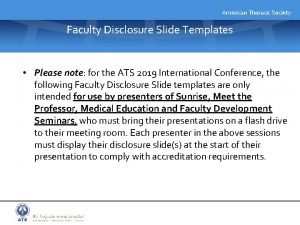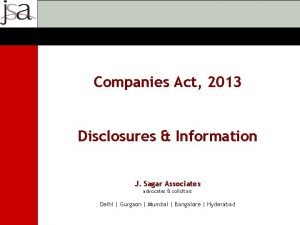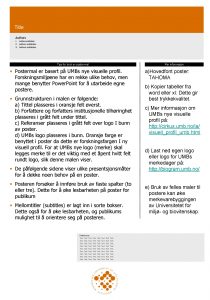FINANCIAL DISCLOSURES The authors have no financial interest












- Slides: 12

FINANCIAL DISCLOSURES The authors have no financial interest in the subject matter of this poster.

CATARACT SURGERY IN PATIENTS ON WARFARIN THERAPY: HAEMORRHAGIC COMPLICATIONS AND POSTOPERATIVE VISUAL ACUITY Paulo Silva Guerra MD, Walter Rodrigues MD, David Lopes MD, Lurdana Gomes MD, M. Monteiro Grillo MD Ophthalmology Department. Director: Prof. Dr. M. Monteiro Grillo Hospital de Santa Maria (HSM) / Lisbon - Portugal

Introduction • Traditionally, warfarin has been discontinued prior to cataract surgery because of concerns about increased risk of hemorrhagic complications • The trend amongst surgeons has shifted strongly towards continuation of anticoagulation • Recent surveys indicates the majority (˃70%) of surgeons keep cataract patients anticoagulated. 5 Purpose: ü To assess ophthalmic complications associated with cataract surgery under topical anesthesia in patients on warfarin therapy.

Material and Methods • Retrospective review of 49 eyes of 42 patients on warfarin therapy (Warfarin Group). • Undergoing cataract surgery by phacoemulsification and IOL placement with topical anesthesia. • We evaluate: - The rates of intraoperative hemorrhagic complications of the anterior and posterior segment - The rates of postoperative hemorrhagic complications of the anterior and posterior segment - The pre and postoperative Best Corrected Visual Acuity (BCVA)

Material and Methods • The results of are compared with a control group, not anticoagulated (age and surgeon matched). • All cataract surgeries were performed by three experienced surgeons from January 2008 to June 2009

Results Demographics Warfarin Group Control Group Patients 42 51 Eyes 49 60 Mean age 75, 3 (SD± 7, 1) 78, 7 (SD± 7, 9) Gender ♂ - 18 (43%) ♂ - 21 (41%) 0, 49 (SD± 1, 86) 0, 56(SD± 2, 02) Preoperative BCVA ü Intraoperative non-hemorrhagic complications Warfarin Group - 2 posterior capsule ruptures Control Group - 3 posterior capsule ruptures

Results Intraoperative Hemorrhagic Complications Warfarin Group n=49 Control Group n=60 0 0 2 (4, 1%) 0 0 0 Subconjunctival hemorrhage Hyphema Suprachoroidal hemorrhage P = 0, 11 2 2 1, 8 1, 6 1, 4 1, 2 1 0, 8 0, 6 0, 4 0, 2 0 0 0 Control Group Subconjunctival H. Warfarin Group Hyphema Suprachoroidal H

Results Postoperative Hemorrhagic Complications Warfarin Group n=49 Control Group n=60 Subconjuntival H. 6 (12, 2%) 1 (1, 7%) P = 0, 02 Hyphema 2 (4, 1%) 0 P = 0, 11 Vitreous Hemorrhage 0 0 Suprachoroidal H. 0 0 4 (8, 1%) 5 (8, 3%) Retinal Hemorrhages 6 Warfarin Group P = 0, 9 Control Group 5 6 4 5 4 2 3 2 1 0 0 0 Subconjuntival H Hyphema Vitreous H Suprachoroidal H Retinal H

Results Postoperative BCVA Warfarin Group n=49 Control Group n=60 BCVA 0, 81 0, 84 SD ± 0, 25 ± 0, 24 Variation 0, 2 -1 0, 3 -1 1 0, 9 0, 8 0, 7 0, 6 0, 5 0, 4 0, 3 0, 2 0, 1 0 Warfin Group Control group P = 0, 58

Discussion • Subconjuntival Hemorrhage: - Most frequent hemorrhagic complication in Warfarin Group - The only statistically significant (P<0, 05) • There was no statistically significant difference in the other hemorrhagic complication between the 2 groups (P>0, 05). • There was no statistically significant difference in postoperative BCVA between the 2 groups (P>0, 05).

Conclusions ü Continuation of treatment with warfarin in patients undergoing phacoemulsification and IOL placement with topical anesthesia is safe and was not associated with increased risk of vision threatening complications.

References 1. Katz J, Feldman MA, Bass EB, Lubomski LH, Tielsch JM, Petty BG et al. Risks and benefits of anticoagulant and antiplatelet medication use before cataract surgery. Ophthalmol. 2003. 110: 1784 -1788 2. Barequet IS, Sachs D, Priel A, Wasserzug Y, Martinowitz U, Moisseiev J et al. Phacoemulsification of cataract in patients receiving Coumadin therapy : ocular and hematologic risk assessment. Am J Ophthalmol. 2007 Nov; 144(5): 719 -23 3. Morris A, Elder MJ. Warfarin therapy and cataract surgery. Clin Experiment Ophthalmol. 2000 Dec; 28(6): 419 -22 4. Carter K, Miller KM. Phacoemulsification and lens implantation in patients treated with aspirin or warfarin. J Cataract Refract Surg. 1998 Oct; 24(10): 1361 -4 5. Ong-Tone L, Paluck EC, Hart-Mitchell RD. Perioperative use of warfarin and aspirin in cataract surgery by Canadian Society of Cataract and Refractive Surgery members: survey. 2005 May; 31(5): 991 -6 6. Stone LS, Kline OR, Sklar C. Intraocular lenses and anticoagulation and anti-platelet therapy. Am Intra-Ocular Implant Soc J. 1985; 11: 165 -68 7. Jonas JB, Pakdaman B, Sauder G. Cataract surgery under systemic anticoagulation therapy with coumarin. Eur J Ophthalmol 2006; 16: 30 -32 8. Rotenstreich Y, Rubowitz A, Segev F et al. Effect of warfarin therapy on bleeding during cataract surgery. J Cataract Refract Surg 2001; 27: 1344 -46
 Aaos disclosure slide
Aaos disclosure slide Voluntary disclosures meaning
Voluntary disclosures meaning Disclosure slide example
Disclosure slide example Website disclosures under companies act 2013
Website disclosures under companies act 2013 Becomes weakness
Becomes weakness Nominal v. real interest rates
Nominal v. real interest rates Effective interest rate
Effective interest rate Simple interest and compound interest
Simple interest and compound interest 8 faces and 6 vertices
8 faces and 6 vertices Hát kết hợp bộ gõ cơ thể
Hát kết hợp bộ gõ cơ thể Ng-html
Ng-html Bổ thể
Bổ thể Tỉ lệ cơ thể trẻ em
Tỉ lệ cơ thể trẻ em






















